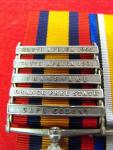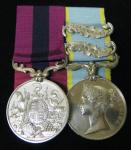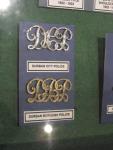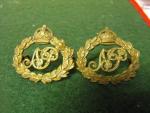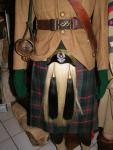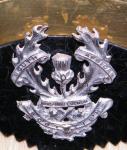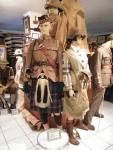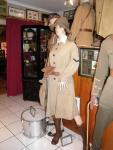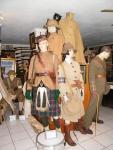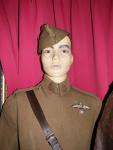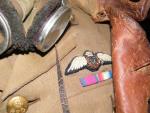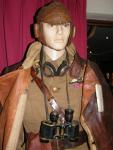
sabrigade
For Deletion-
Posts
1,707 -
Joined
-
Last visited
-
Days Won
34
Content Type
Profiles
Forums
Blogs
Gallery
Events
Store
Everything posted by sabrigade
-
Archibald Frank Thomson was 31 years old when he attested in the South African Service Corps Mechanical Transport and he was destined for service in the former Nyasaland. He listed his trade as a driver/mechanic and was single at the time. His next of kin was his mother and his place of record was in Cape Town. As a veteran of the Anglo-Boer War, Thompson had served in Driscoll's Scouts and the Second Railway Pioneer Regiment. He was awarded the Queen's South Africa medal with 5 clasps: Cape Colony; Orange Free State; Transvaal; South Africa 1901 and South Africa 1902. The Scouts participated in the guerilla war and became a five squadron strong force before being disbanded. Driscoll's Scouts were raised in Aliwal North in March 1900 as a body of scouts. They served with the Colonial Division. Their founder and commander was Captain Dan Driscoll, an Irish Protestant who had paid his own way to South Africa. The Railway Pioneer Regiment was established to protect and repair railways, bridges, culverts and lines that had been damaged. It was commanded by Major J.E. Capper from the Royal Engineers and was used mainly on the Cape Town to Pretoria railway line and route. The regiment was also used on armored trains and did very good work during the guerilla phase of the Anglo-Boer War. Thompson was a trumpeter in his Regiment. After the Anglo Boer War had ended in 1902, the first motor car in Johannesburg was registered in 1904, the first American imports arrived in 1906, and the first motor show was held in 1908. The Transvaal Automobile Club was formed in 1903, just 17 years after the founding of Johannesburg itself, to foster what was then called "automobilism". The club's motoring activities included the compilation of road maps, organizing hill climbs and campaigning against the prevailing speed limit of ten miles an hour within a radius of two miles of the Rissik Street post office in the center of Johannesburg. The 1914 Rebellion occurred in South Africa in 1914 at the start of the First World War. in which men who supported the recreation of the former Boer Republics rose up against the government. Many members of the government were themselves former Boers who had fought with the rebels against the British in the Anglo Boer, which had ended twelve years earlier. The rebellion failed, and the ringleaders received heavy fines and terms of imprisonment. One of the main leaders was General Christiaan De Wet who was a very well known guerilla leader in the war. Some major engagements occurred during the rebellion and the official history states that 132 members of the government forces were killed and 242 wounded. Rebel losses were put at 190 killed and between 300 and 350 wounded. The No 2 Special Motor Car Contingent had been organized by the Transvaal Automobile Club. Thomson enrolled in the contingent on the 6th of November 1914 as a driver. He was discharged on 17 January 1915, his unit having fulfilled and completed its important role in combating the 1914 rebellion within the Union of South Africa. The motor contingent was active in the rounding up of General Christian De Wet and his followers. By persistent and determined travelling the motor transport corps was able to "capture" De Wet and his men. The cars or automobiles became an example of mobility combined with firepower. The 110 vehicles were supplied by the Transvaal Automobile Club and cars hired from D.H. Saker and Company of Johannesburg. The contingent, which included one motor-borne machine gun section complete with 16 Rexer light machine guns, was divided into two sections under the command of Captains Bullock and Saker. Although Bullock and Saker harbored intense but petty personal jealousies for each other, the contribution of the two motorized commandos was significant. Cecil Nurcombe, who served with one of these motorized machine-gun detachments, wrote that the conversion of these cars into light armored units allowed government forces to outmaneuver mounted rebel commandos, even in some of the most difficult terrain. The commemorative history of the rebellion that was published by the Transvaal Leader in 1915 also noted the contributions made by the motorcar fleet 'which harassed the rebels day and night, and which surprised all with its effectiveness over rough country'.'' The contingent chased de Wet who was aiming to break through into German South West Africa via Henning's Vlei in the Vryburg district to link up with the rebel Maritz. De Wet surrendered to Colonel Jordaan after the grueling cross country chase. General De Wet credited the motor cars for his capture. He also informed his captors that he had not expected the cars to be able to transverse the very arid area in which he had been pursued and captured. He had been able to only rest and remove the saddles from his horses once for a few minutes in 50 miles! The 1914/15 star was not awarded to members of the Motor Car contingent as these events of the 1914 Rebellion took place within the borders of the Union of South Africa and were regarded an internal South African issue by the Imperial Authorities. After the Rebellion Thomson re-attested with the S.A. Service Corps Mechanical Transport for service in Nyasaland from 1 March 1916 and he was promoted to Driver Sergeant, Staff Sergeant, Company Sergeant Major and then 2nd Lieutenant. He returned to the Union on 1 October 1917 on account of ill health which was common to the German East African Campaign during the First World War.
-
http://gmic.co.uk/uploads/monthly_09_2010/post-3034-128428626752.jpghttp://gmic.co.uk/uploads/monthly_09_2010/post-3034-128428627072.jpg A few months ago I purchased these wings. I initially thought that it may have had an Australian connection or had been miss-spelt by the manufacturer. In his excellent book, "Eagles Recalled: Pilot and Aircrew Wings of Canada, Great Britain and the British Commonwealth 1913-1945 "by Warren Carroll, he has a seperate chapter(11) on the first issue wings of the RAF. He has various descriptions and photographs of this very scarce item, including a printed letterhead on a writing block. Warren Carroll refers to the wing as the "TORONTO WING". In the relevent chapter, Warren Carroll states that the wing would have been presented/approved by the authorities between May and August 1918. I believe this another example of the early wing which has ARF and not RAF monograms on it. Any comments would be welcomed. Regards, Will
-
William Grundy was born in Liverpool, Lancaster. As a young man, he enlisted with the HM49TH regiment. He was allocated the regimental number of 1843. After arriving in Hong Kong on 4 June 1842, he saw service in Chusan, Hong Kong, Singapore and India. After serving abroad for almost a year, he returned to Portsmouth on 16 August 1843. Service followed in England and Ireland until 1848. The promotion to Corporal was confirmed on 6 May 1848. Corporal Grundy continued to serve in Dublin and Galway until promotion to Sergeant followed on 1 May 1849. Towards the end of 1853, Grundy was the recruiting sergeant in Ottery Saint Mary and Bath. On 29 March 1854, he embarked at Kingston for service with the Service companies of his Regiment. From April to June 1854, he was in Malta and Turkey and reached the Crimea in September 1854. From January to June 1854, the Regiment was based or camped in front of Sebastopol. Promotion to Colour Sergeant was confirmed on 1 April 1854. The British Army suffered heavy casualties during the Assault on the Quarries in front of the Redan on 7 June 1855. One of them was Colour Sergeant William Grundy who succumbed to his wounds on the same day. For his services, he was awarded the Distinguished Conduct Medal and the Crimean Medal with 2 clasps
-
MIXED GROUP - INCL. RED CROSS
sabrigade replied to Mervyn Mitton's topic in Great Britain: Orders, Gallantry, Campaign Medals
Hi Mervyn, I agree completely. I have a file on each individual's medal group that I have been privileged to take care of. I believe in detail research. Regards, Will -
http://gmic.co.uk/uploads/monthly_08_2010/post-3034-128231764062.jpghttp://gmic.co.uk/uploads/monthly_08_2010/post-3034-128231764705.jpg MY RAILWAY POLICE AND ASSOCIATED BADGES This police force was established in 1916 to police the country's railways and harbours. It was also responsible for air services. The SARP was modeled on the SAP, and also awarded the King's/Queen's Police Medal. The badges in the photographs form part of my collection. I do not have much information on them so any inputs would be appreciated. Regards, Will
-
MIXED GROUP - INCL. RED CROSS
sabrigade replied to Mervyn Mitton's topic in Great Britain: Orders, Gallantry, Campaign Medals
Hi Mervyn, Some "ENDLEY" inputs. The 1914-15 Star was issued to South Africans for service in the then German South West Africa. Some South Africans were issued with the 1914 Star and they were members of the RFC who were in England for flight training when the war started. They were granted permission to serve on the Western Front but were later summoned to serve in the GSWA and the East African campaign where they formed no 26 Squadron of the RFC. The most noted member of this group was General "Sir" Kenneth Van der Spuy who was captured during Operation Archangel. The 8th Mounted Rifles were the "MIDDELANDSE RUITERS" in GSWA. The Roll Call or list I have for Delville Wood lists a Pte D.A. Frankenstein of the 3RD SAI who was wounded in the Battle. The 3RD SAI was the Transvaal and Rhodesia Regiment. The 3RD SAI was disbanded in 1918 when the British Brigades were reduced from four infantry or rifle battalions to three. It is possible that your man was transferred to the 4th SAI after his battalion was disbanded. The 4th SAI was the South African Scottish Regiment. I would suggest you check and confirm the date for his wounds as the Brigade entered the Wood on the 15th of July and were relieved on the 20th of July 1916 at 18h00 in the evening. Casualties sustained were 2320 men and the only time the Brigade returned to the Wood was for a medal and memorial ceremony on 17 February 1918. During late July 1916, new South African drafts arrived from Bordon in England to replace the losses and the Brigade was reformed. These new drafts consisted of approximately 40 officers and 2826 men. The next action was from the 23rd of August 1916 when the Brigade did front line trench duty in the Vimy area. The 1ST SOUTH AFRICAN INFANTRY BRIGADE never became the or a 2ND BRIGADE, the 2nd and 3rd South African Brigades served in German East Africa. In 1918, after the German Offensive the Brigade became a Composite Battalion due to major losses but was later again established as a South African Brigade. I dont have my major sources and references with me in Khartoum so I apologize for my limited input. Hope it helps! Regards, Will





